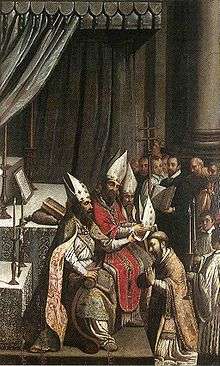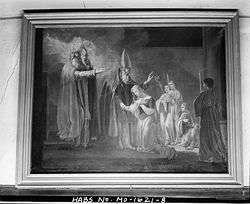Consecration
Consecration is the solemn dedication to a special purpose or service. The word consecration literally means "association with the sacred". Persons, places, or things can be consecrated, and the term is used in various ways by different groups. The origin of the word comes from the Latin stem consecrat, which means dedicated, devoted, and sacred.[1] A synonym for to consecrate is to sanctify, a distinct antonym is to desecrate.
Buddhism
Images of the Buddha and bodhisattvas are ceremonially consecrated in a broad range of Buddhist rituals that vary depending on the Buddhist traditions. Buddhābhiseka is a Pali and Sanskrit term referring to these consecration rituals.[2]
Christianity
Roman Catholic Church

"Consecration" is used in the Catholic Church as the setting apart for the service of God of both persons and objects.
Ordination of bishops
The ordination of a new bishop is also called a consecration. While the term "episcopal ordination" is now more common,[3] "consecration" was the preferred term from the Middle Ages through the period including the Second Vatican Council (11 October 1962 – 8 December 1965).[4]
The Vatican II document Constitution on the Sacred Liturgy n. 76 states,
Both the ceremonies and texts of the ordination rites are to be revised. The address given by the bishop at the beginning of each ordination or consecration may be in the mother tongue.
When a bishop is consecrated, the laying of hands may be done by all the bishops present.
The English text of Catechism of the Catholic Church, Second Edition, 1997, under the heading "Episcopal ordination—fullness of the sacrament of Holy Orders", uses "episcopal consecration" and "episcopal ordination" interchangeably (CCC, 1556–1558).
The Code of Canon Law Latin-English Edition (1983) under "Title VI—Orders" uses the term sacrae ordinationis minister "minister of sacred ordination" and the term consecratione episcopali "episcopal consecration" (CCL, 1012, 1014).
Consecrated life

Those who enter religious institutes, secular institutes or societies of apostolic life are also described as living the consecrated life.
The rite of consecration of virgins can be traced back at least to the fourth century.[5] By the time of the Second Vatican Council, the bestowal of the consecration was limited to cloistered nuns only.[6] The Council directed that this should be revised.[7] Two similar versions were prepared, one for women living in monastic orders, another for consecrated virgins living in the world. An English translation of the rite for those living in the world is available on the web site of the United States Association of Consecrated Virgins.[8]
Churches, altars, and other ritual objects
Chrism, an anointing oil, is (usually scented) olive oil consecrated by a bishop.
Objects such as patens and chalices, used for the sacrament of the Eucharist, are consecrated by a bishop, using chrism. The day before a new priest is ordained, there may be a vigil and a service or Mass at which the ordaining Bishop consecrates the paten(s) and chalice(s) of the ordinands (the men who are transitional deacons, about to be ordained priests).
A more solemn rite exists for what used to be called the "consecration of an altar", either of the altar alone or as the central part of the rite for a church. The rite is now called the dedication.[9][10] Since it would be contradictory to dedicate to the service of God a mortgage-burdened building, the rite of dedication of a church is carried out only if the building is debt-free. Otherwise, it is only blessed.
Eucharist
A very special act of consecration is that of the bread and wine used in the Eucharist, which according to Catholic belief involves their change into the Body and Blood of Christ, a change referred to as transubstantiation. To consecrate the bread and wine, the priest speaks the Words of Institution.
Eastern churches
In the Eastern Orthodox Churches and the Eastern Catholic Churches, the term "consecration" can refer to either the Sacred Mystery (sacrament) of Cheirotonea (ordination through laying on of hands) of a bishop, or the sanctification and solemn dedication of a church building. It can also (more rarely) be used to describe the change of the bread and wine into the Body and Blood of Christ at the Divine Liturgy. The Chrism used at Chrismation and the Antimension placed on the Holy Table are also said to be consecrated.
Protestant churches
Church buildings, chapels, altars, baptismal fonts, and Communion vessels are consecrated for the purpose of religious worship.
A person may be consecrated for a specific role within a religious hierarchy, or a person may consecrate his or her life in an act of devotion. In particular, the ordination of a bishop is often called a consecration. In churches that follow the doctrine of apostolic succession (the historical episcopate), the bishops who consecrate a new bishop are known as the consecrators and form an unbroken line of succession back to the Apostles. Those who take the vows of religious life are said to be living a consecrated life.
The Methodist Book of Worship for Church and Home (1965) contains a liturgies for "The Order for the Consecration of Bishops", "An Office for the Consecration of Deaconesses", "An Office for the Consecration of Directors of Christian Education and Directors of Music", as well as "An Office for the Opening or Consecrating of a Church Building" among others.[11] Among some religious groups there is a service of "deconsecration", to return a formerly consecrated place to secular purpose (for instance, if the building is to be sold or demolished). In the Church of England (Mother Church of the Anglican Communion), an order closing a church may remove the legal effects of consecration.
Mormonism
Mormonism is replete with consecration doctrine, primarily Christ's title of "The Anointed One" signifying his official, authorized and unique role as the savior of mankind from sin and death, and secondarily each individual's opportunity and ultimate responsibility to accept Jesus' will for their life and consecrate themselves to living thereby wholeheartedly. Book of Mormon examples include "sanctification cometh because of their yielding their hearts unto God" (Heleman 3:35) and "come unto Christ, who is the Holy One of Israel, and partake of his salvation, and the power of his redemption, ... and offer your whole souls as an offering unto him, and continue in fasting and praying, and endure to the end; and as the Lord liveth ye will be saved" (Omni 1:26).
Hinduism
In most South Indian Hindu temples around the world, Kumbhabhishekam, or the temple's consecration ceremony, is done once every 12 years. It is usually done to purify the temple after a renovation or simply done to renew the purity of the temple. Hindus celebrate this event on the consecration date as the witnessing gives a good soul a thousand "punya", or good karma.[12]
Jainism
Panch Kalyanaka Pratishtha is a traditional Jain ceremony that consecrates one or more Jain Tirthankara icons with celebration of Panch Kalyanaka (five auspicious events). The ceremony is generally held when a new Jain temple is erected or new idols are installed in temples.[13] The consecration must be supervised by a religious authority, an Acharya or a Bhattaraka or a scholar authorized by them.
Islam
Consecration is less prominent in Islam than in many other religions, because Islamic belief stresses the divine omnipresence: as everything is in permanent contact with the Divine, special consecration is not often a religious requirement.
Nonetheless, it is a feature of Muslim religious life in some cases. For example,
- In salah (prayer), once one has said the takbir to begin, one is in a specially consecrated state and may not talk, eat, or do other worldly things.
- Once the sacred month of Ramadan has entered, Muslims are expected to dedicate themselves to the fast and are also expected to make more than the usual effort to avoid wrongdoing.
- On the Hajj, once one has passed the Mawaqit, one must enter a state of consecration in which all wrongdoing is strenuously prohibited, as are some normally licit activities such as hunting, engaging in marital relations, and cutting or plucking one's hair.
- By the intention of building a masjid (dedicated mosque) upon it, land becomes permanently dedicated to God and cannot be owned by any human being. One may thereafter not enter inside the designated perimeter except in a state of ritual purity, and the land may never revert to any other use.
See also
- Consecrated virgin
- Cornerstone
- Dedication
- Nazirite
- Vow
Notes
- "Definition of CONSECRATE". www.merriam-webster.com. Retrieved 2019-06-03.
- Jr, Robert E. Buswell; Jr, Donald S. Lopez (2013-11-24). The Princeton Dictionary of Buddhism. Princeton University Press. ISBN 9781400848058.
- "By a margin of 5:1 on the Vatican website, e.g." Retrieved 31 October 2013.
- See, e.g., the Vatican II decree Christus Dominus on the Pastoral Office of Bishop, which exclusively uses the term "consecration", rather than "ordination", to refer to the act by which a priest becomes a bishop.
- The Sacraments (Liturgical Press, 1987, ISBN 978-0-8146-1365-8), p. 211
- Apostolic Constitution Sponsa Christi – AAS 43 (1951), 16
- Sacrosanctum Concilium Archived February 21, 2008, at the Wayback Machine, 80
- "Wayback Machine" (PDF). web.archive.org. 2009-02-07. Retrieved 2019-06-03.
- Caeremoniale Episcoporum. chapters IX-XI
- Roman Missal, Ritual Masses for the Dedication of a Church and an Altar
- The Book of Worship for Church and Home: With Orders of Worship, Services for the Administration of the Sacraments and Other Aids to Worship According to the Usages of the Methodist Church. Methodist Publishing House. 1964. pp. 53–354. Retrieved 25 March 2017.
- "Account Suspended". modernhinduculture.com. Retrieved 2019-06-03.
- Jaini, Padmanabh S. (1998) [1979], The Jaina Path of Purification, Delhi: Motilal Banarsidass, ISBN 81-208-1578-5
Bibliography
- Service Book of the Holy Orthodox-Catholic Apostolic Church, Isabel F. Hapgood (Antiochian Orthodox Christian Archdiocese of North America, New York) 1975.
- Orthodox Dogmatic Theology: A Concise Exposition, Protopresbyter Michael Pomazansky (Tr. Hieromonk Seraphim Rose, Saint Herman of Alaska Brotherhood, Platina CA) 1984.
- The Law of God, Archpriest Seraphim Slobodskoy (Tr. Holy Trinity Monastery, Jordanville NY) 1996.
External links
| Wikiquote has quotations related to: Consecration |
- Consecration article in Catholic Encyclopedia
- Consecration of an Orthodox Church 6 pages of photos, Serbian Orthodox Church
- Photos of Consecration of Altar and Antimens in the Russian Orthodox Church
- The Sanctification of Holy Chrism by the Ecumenical Patriarchate
- Virginity article in Catholic Encyclopedia discussing Consecration of a Virgin
- Kumbhabhishekam by the Modern International Hindu Agamic Cultural Organisation
